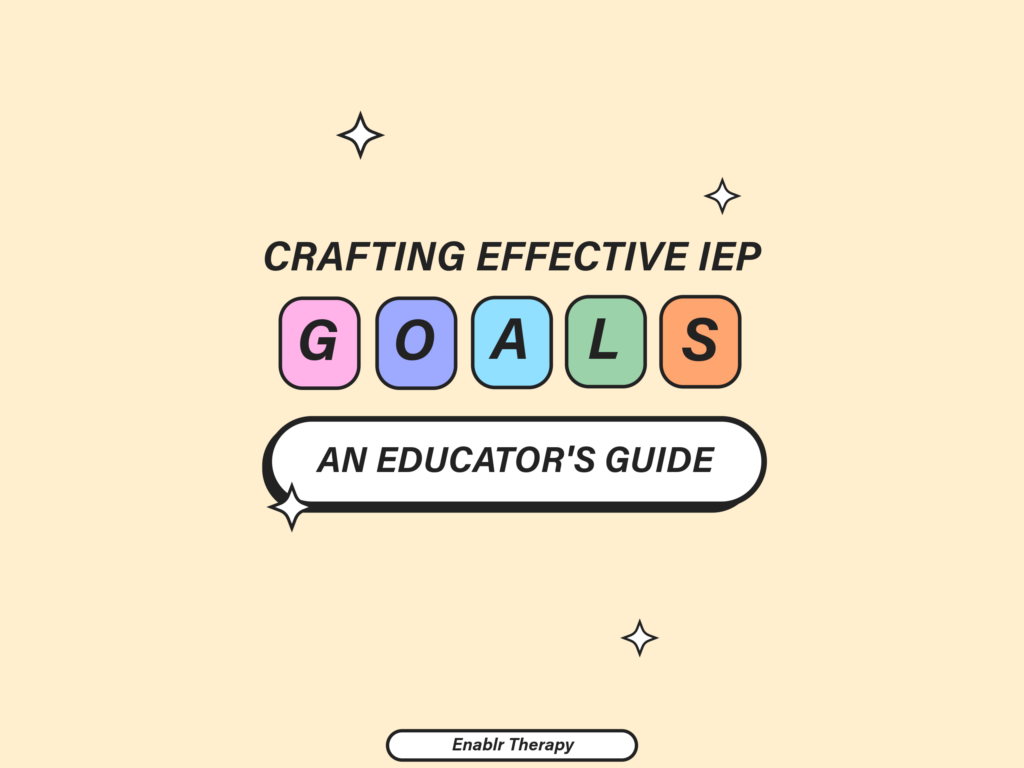In the realm of special education, Individualized Education Program (IEP) goals serve as the cornerstone of student success. These goals outline personalized objectives tailored to address the unique needs of each student with a disability, guiding educators in providing targeted interventions and support. However, crafting meaningful and effective IEP goals requires careful consideration and expertise. In this guide, we’ll explore the essential elements of writing impactful IEP goals and provide practical tips for educators to ensure they are comprehensive, measurable, and aligned with students’ individual needs.
An IEP goal is a statement that describes what a student with a disability is expected to achieve within a specific timeframe. These goals are designed to address areas of need identified through comprehensive evaluations and assessments. Goals should be foundational, building on the students’ abilities to address key skills needed for achievement in academic and functional domains. They should also be meaningful to the student, family, and team, helping the student move toward their life ambitions. IEP goals provide a roadmap for guiding instruction, monitoring progress, and measuring outcomes for students receiving special education services.
IEP goals should not be vague or general.
Best practice is to use a SMART format when writing an IEP goal. SMART is an acronym for:
- Specific: IEP goals should be clear, concise, and specific, leaving no room for ambiguity. They should clearly articulate the desired observable behavior or skill being targeted, and the conditions under which progress will be measured. Action verbs should be used to describe observable behaviors or skills that the student will demonstrate. Examples include “identify,” “solve,” “write,” “read,” “calculate,” “demonstrate,” “respond to,” etc. Anyone reading the goal should be able to visualize what the child must do in order to meet the goal.
Some examples of vague vs specific goals are shown below.
| Vague | Specific (Observable) |
| The student will improve reading. | During classroom reading group, the student will read a 2nd grade-level book orally at a rate of 40 words per minute |
| The student will demonstrate appropriate classroom behavior | When asked by school staff “How are you feeling?”, the student will correctly identify his sensory alertness level (red, orange, green, blue) and then select an appropriate strategy from the corresponding sensory activity choice board to help him regulate his sensory system. |
| The student will comprehend a story after reading it. | After reading a story in the classroom reading group, student will answer Who, Where, and When questions related to the story. |
- Measureable: A good IEP goal is measurable, meaning progress can be quantified or observed objectively. It should include criteria for success and a method for collecting data to track progress over time. Measurable goals enable educators to monitor student progress, make data-driven decisions, and determine whether interventions are effective.
Let’s take the goals above and make them measurable.
- During classroom reading group, the student will read a 2nd grade-level book orally at a rate of 40 words per minute with 90% accuracy across 3 data collection days as measured by teacher data collection.
- When asked by school staff “How are you feeling?”, the student will correctly identify his sensory level (red, orange, green, blue) and then select an appropriate strategy from the corresponding sensory activity choice board to help him regulate his sensory system in 3 out of 4 opportunities across 4 out of 5 data collection days as measured by teacher and therapist report and data collection.
- After reading a story in the classroom reading group, student will answer Who, Where, and When questions related to the story with 80% accuracy across 4 out of 5 days as measured by teacher and speech therapist data collection.
- Achievable: IEP goals should be challenging yet attainable, taking into account the student’s current abilities, instructional level, and rate of progress. Goals that are too easy may not adequately challenge the student, while goals that are too difficult may lead to frustration and disengagement. It’s essential to strike a balance and set goals that stretch the student’s abilities without overwhelming them. Giving consideration to the student’s present levels of academic achievement and functional performance (PLAAFP) and baseline data when setting goals will help to ensure that they are realistic and achievable within the IEP time frame.
Generally speaking, goals that are not met should not automatically be carried over from year to year. Instead those goals and related data should be analyzed and then modified as needed. Breaking down complex skills into smaller, more manageable steps or objectives may help to facilitate progress and skill development.
- Relevant: IEP goals should be relevant to the student’s educational needs, functional abilities, and long-term goals. They should address areas of need that impact the student’s ability to access the general education curriculum, participate in school activities, and make meaningful progress towards post-school outcomes. Goals should be aligned with the student’s strengths, interests, and individualized learning preferences whenever possible.
- Time-Bound: Every IEP goal should have a clear timeframe or deadline for achievement, typically within the duration of the IEP cycle (usually one year). Setting specific timelines helps create a sense of urgency, establishes accountability, and allows for regular progress monitoring and review. Educators should periodically assess progress towards goal attainment and make adjustments as needed to ensure timely completion.
Adding a timeline to one of the goals above may look like this:
By the student’s next IEP review in May, 2025, Student will read a 2nd grade-level book orally at a rate of 40 words per minute with 90% accuracy across 3 data collection days as measured by teacher data collection.
Practical Tips for Writing Good IEP Goals:
- Collaborate with the IEP team, including parents, students (when appropriate), general education teachers, and related service providers, to develop goals that reflect a shared understanding of the student’s needs and priorities.
- Align goals with state academic standards, curriculum frameworks, and grade-level expectations to promote access to the general education curriculum and facilitate smooth transitions between educational settings.
- Review and revise IEP goals regularly based on ongoing progress monitoring data, adjusting goals as needed to reflect the student’s evolving needs, strengths, and areas for growth even if this means that the IEP is modified more often than the yearly requirement.
IEP Goal Formula:
Putting all of the SMART components together, you can follow a general formula for writing IEP goals.
By (time frame), during/in (setting/context), Student will (specific observable action/skill) with (needed supports) with (accuracy) across (duration) as measured by (measurement/ data collection method).
Crafting effective IEP goals is a collaborative and iterative process that requires careful consideration of the student’s unique needs, abilities, and goals. By following the key principles outlined in this guide and incorporating practical tips for writing good IEP goals, educators can develop meaningful and measurable objectives that support student growth, achievement, and success in school and beyond. Together, we can ensure that every student with a disability receives the individualized support they need to reach their full potential.
Contact us to learn more!


